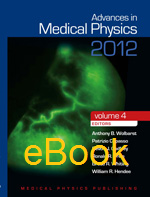
Advances in Medical Physics: 2012
Author: Anthony B. Wolbarst, Patrizio Capasso, Devon J. Godfrey, Ronald R. Price, Bruce R. Whiting, William R. Hendee, EditorsISBN: 9781930524767
Published: 2012 June | ISSN: 2156-2008 | 330 pp | eBook
Price: $ 115.00
Doody's Publishers' Club | Mar 2013
Description
The fourth volume in the biennial Advances in Medical Physics series, this book follows the same general outline of previous volumes and covers aspects of basic imaging modalities, a topic related to radiation oncology, new imaging modalities, radiation safety, and public, professional, and regulatory issues. Chapters are written by leaders in the various fields.
Purpose
It is difficult for books on medical imaging to keep current. Popular textbooks do a good job of teaching the basics and presenting technology in detail, but a book like this serves to bridge the informational gap and provide a snapshot of the gains in knowledge and technical advances in a timely manner. It is reminiscent of the yearly updates of encyclopedias of the past that were so beneficial before the age of the Internet. This book also serves the purpose of providing timely information on advances in areas of medical physics that an individual physicist might not be involved with. It also provides relevant technical information on topics of interest to nonphysicists who are involved with medical imaging.
Audience
The book is written at a level that will have wide appeal. Graduate students in medical physics should find the book interesting, providing a glimpse at the breadth and complexity of the medical imaging field. Much of the book relates to diagnostic imaging, but since imaging now plays a greater role in radiation oncology, individuals practicing in that field will find pertinent information. Radiology residents who are interested in grasping concepts of new technology will find it helpful. Finally, medical physicists with established careers and interests in other subspecialties will also gain useful information.
Features
The book is filled with treatises on advances, but it also includes basic principles for given topics. The chapter on imaging in radiation oncology provides a basic guide to the use of all of the standard imaging systems in treatment planning and treatment systems and some of the issues, and describes the mechanics of 3-D planning, IMRT, and IGRT. The book covers the general imaging systems of CT, fluoroscopy, and ultrasound in detail. Currently, CT systems are in the forefront, and in recognition of this, three chapters cover topics from equipment to acquisition to dosimetry. The section on advances in ultrasound provides information on new topics, such as elastography and strain imaging as well as new transducers and portable ultrasound. A chapter on diffusion tensor imaging includes a generous amount of detail on the principles and mathematics, but it also covers applications and discusses fiber tracking. For those not in the field but wishing to learn about the methods that are becoming routine in neuroimaging, this will serve as a reference point. On a more routine aspect of MRI, a chapter discusses MRI safety, a current significant topic. Of particular importance is the issue of implanted devices and issues regarding testing for suitability in a magnet. A current buzzword is molecular imaging and this is featured in sections from two areas: small animal positron emission tomography and near-infrared fluorescence. A number of interesting chapters cover professional and public interests -- one discusses stochastic risk in radiation and the relation to individual cells of an organ that are irradiated, and another covers risk communication, identifying aspects of the theory of risk perception by the populace and communication issues. Regulatory affairs are also addressed in several chapters. One covers the CRCPD (Conference of Radiation Control Program Directors), an entity that many medical physicists are probably aware of, but may not be well informed about. Another covers radioactive materials regulatory programs, which is a compendium of the current regulatory climate and gives a good synopsis of its many aspects. The one chapter that was a surprise covers consequences of a nuclear detonation. It is not a subject I relish, because it is the antithesis of imaging. However, after thinking about it, there are two purposes that this chapter may serve. One is that it presents the consequences of such an event as a point of information, and the other is, as an illustration of radiation at its worst, it demonstrates why we should desire to prevent such an occurrence ever again.
Assessment
This is a quality book, albeit with one minor inconvenience. Gray scale pictures appear throughout the book, while a number of color photos are grouped together in one section, which makes it necessary to flip back and forth to view them when reading a chapter. However, the book covers a wide array of topics and has much to offer a broad audience. I recommend this book for medial physicists wanting to have a single source of advances in medical imaging, for medical physics graduate students, and, given that much of the material is at a basic level, for diagnostic radiologists and residents interested in obtaining current information on the leading edge of technology in their chosen field.
Michael Yester, PhD, DABR, FAAP
University of Alabama at Birmingham


